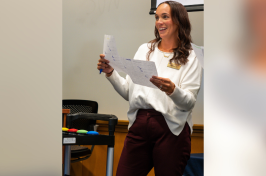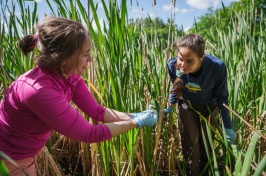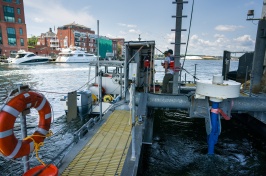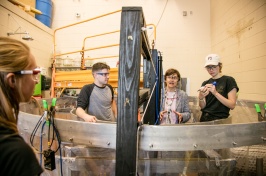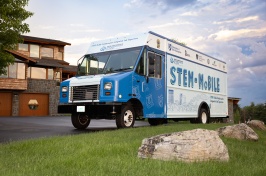UNH Reports: New Hampshire Getting Warmer, Wetter as Climate Changes
DURHAM, N.H. - As heat-trapping gases from the burning of fossil fuels and other human activities continue to accumulate in the atmosphere, average annual temperatures in New Hampshire will likely rise by 3 to 5 degrees Fahrenheit and extreme precipitation events will likely double by mid-century, according to two University of New Hampshire reports released today.
The reports, "Climate Change in New Hampshire: Past, Present, and Future," were commissioned by the Granite State Future project and cover northern and southern New Hampshire. They are intended to provide decision-relevant information as municipalities and regions face challenging choices regarding future investments.
The reports can be downloaded here:
"The most striking result from the climate assessment is that the recent increase in extreme precipitation events is likely to continue into the future," says Cameron Wake, research associate professor at the UNH Institute for the Study of Earth, Oceans, and Space, director of Climate Solutions New England (CSNE), and lead author of the study.
CSNE, an initiative of the UNH Sustainability Institute, was tasked by the Granite State Future project to assess past and potential future climate change across New Hampshire. The resulting reports detail how the state has been getting warmer and wetter over the last century, how the rate of change has increased over the last four decades, and how those trends will likely continue over the 21st century.
Adds Wake, the UNH Josephine A. Lamprey Professor in Climate and Sustainability, "More frequent extreme precipitation events combined with development in our watersheds will likely lead to more frequent and larger flooding events. If we decide to deal with this issue, the good news is that we have the time, the tools, and the civic structures to help our communities become more resilient to future flooding events."
"The 'Climate Change in New Hampshire' reports are a resource for local communities to understand the range of potential impacts that they may face in the near future," says Kerrie Diers, executive director of the Nashua Regional Planning Commission and an active partner in the Granite State Future project. "As many communities strive to become more resilient, they need to be able to identify and implement cost-effective actions to both mitigate and adapt to changing climate patterns."
Explains Justin Kates, director of emergency management for Nashua, "Nashua has taken the initiative to involve long-term climate data into our emergency planning and these reports help us better gauge potential increases in demand for emergency services and the need for infrastructure adaptation due to extreme temperatures, flood events, and major storms."
In the absence of concerted efforts to reduce greenhouse gas emissions, CSNE found that New Hampshire could see the following changes by the end of the century:
⢠Average annual temperatures may rise as much as 4 to 9 degrees Fahrenheit across the state;
⢠Summer temperatures may experience the most dramatic change, up 11 degrees Fahrenheit or higher. The frequency of extreme heat days is projected to increase dramatically, and the hottest days will be hotter, impacting human health, infrastructure, and the electrical grid;
⢠Extreme cold temperatures may occur less frequently, and extreme cold days may be warmer than in the past. Warming winters will reduce opportunities for snow- and ice-related recreation (and related economic activity). Winter warming would also reduce cold temperature constraints that currently limit the range of some pests and invasive species;
⢠The growing season may get longer, which may provide opportunities for farmers to grow new crops. However, many existing crops will likely experience yield losses associated with increased frequency of high temperature stress, an increase in soil erosionâ¨and crop failure resulting from more frequent extreme precipitation events, inadequate winter chill period for optimum fruiting, and increased pressure from invasive weeds, insects, or disease;
⢠Annual average precipitation may increase 14 to 20 percent across the state. Precipitation events that drop more than four inches of precipitation in 48 hours are projected to increase two- to three-fold.
CSNE promotes regional collaboration in pursuit of greater energy self-reliance and weather resilience that contribute to healthy, prosperous, and sustainable communities across New England. Learn more at www.climatesolutionsne.org. CSNE is an initiative of the Sustainability Institute at UNH. As a nationally recognized leader in sustainability, UNH draws on the Sustainability Institute to act as convener, cultivator, and champion of sustainability on campus, in the state and region, and around the world. Learn more at http://www.sustainableunh.unh.edu.
The Granite State Future project is a community-based program predicated on an ongoing public dialogue about what citizens want for the future of their communities, regions, and the state. The three-year project will explore ways to improve towns and the state as a whole and will culminate with an update of the regional plans in each of New Hampshire's nine planning regions. Learn more at www.granitestatefuture.org.
The reports' research was completed on behalf of the state's nine Regional Planning Commissions (RPCs) and carried out under contract with the Nashua RPC and the Granite State Future project using Sustainable Communities Regional Planning Grant funds administered by the U.S. Department of Housing and Urban Development.
The University of New Hampshire, founded in 1866, is a world-class public research university with the feel of a New England liberal arts college. A land, sea, and space-grant university, UNH is the state's flagship public institution, enrolling 12,300 undergraduate and 2,200 graduate students.
Report cover images to download: http://www.eos.unh.edu/newsimage/2014_NorthernNH_cover_lg.jpg
http://www.eos.unh.edu/newsimage/2014_SouthernNH_cover_lg.jpg
-30-
Reporters and editors: Cameron Wake can be reached at (603) 862-2329, cameron.wake@unh.edu, and @theclimatedr
Latest News
-
October 30, 2024
-
October 10, 2024
-
October 8, 2024
-
October 3, 2024
-
October 1, 2024








